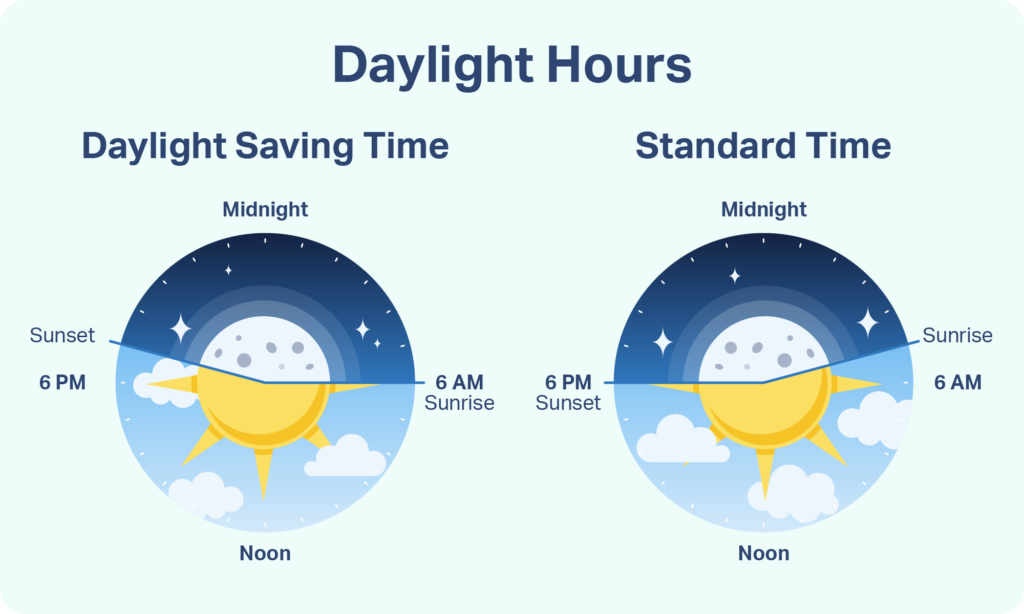Latest Updates: Daylight Saving Time in 2024

- Clocks will “spring forward” one hour at 2 a.m. local time on Sunday, March 10, 2024.
- Federal law still prohibits states from enacting permanent daylight saving time (DST).
- Proposed legislation to change federal law, such as Senator Marco Rubio’s Sunshine Protection Act, has remained stalled since gaining initial momentum in 2022.
- Dozens of states continue to consider proposals to adopt either permanent daylight saving time or permanent standard time. Yet, no states have adopted a legislative change since 2022.
- Without new movement on proposed changes, Americans should expect clock changes to continue into 2024.
Daylight Saving Time: Latest News and Policy Updates
Despite many Americans’ aversion to having to “spring forward” and “fall back” each year, all signs point to continued twice-yearly clock changes. No major legislative changes to daylight saving time (DST) were enacted recently, so clocks will spring forward on Sunday, March 10.
Federal law prohibits states from switching to permanent daylight saving time. Changes to federal law, including the Sunshine Protection Act, stalled in 2023 have yet to come up for a vote in 2024. Dozens of U.S. states are considering legislation to eliminate clock changes. But there has been relatively little momentum compared to recent years.
What Is the Sunshine Protection Act?
The Sunshine Protection Act is a bill that has been regularly introduced in the U.S. Senate by Senator Marco Rubio of Florida. Representative Vern Buchanan (R-FL) also introduced it in the House of Representatives in March 2023. The bill would establish permanent daylight saving time nationwide. Under the bill’s provisions, there would be no clock changes in the spring and fall.
The Sunshine Protection Act has yet to be presented to Congress in 2024. The versions of the bill that were introduced in 2023 remain in committee with no recent activity.
Arizona, Hawaii, and U.S. territories already following permanent standard time would be exempt from the law. These states and territories would continue using their current system of permanent standard time. Any other state that adopted permanent standard time before the Sunshine Protection Act became law would also be exempt.
The law’s effects would be most apparent from November to March when clocks would otherwise be on standard time. In general, daylight saving time means less light in the morning. So, during these months, people with typical work and school schedules would be more likely to start the day in the dark.
That said, the effects of the Sunshine Protection Act would vary by location. The amount of daylight throughout the year depends on how far a place is from the equator. In addition, cities in the western parts of each time zone have later sunrises, which can mean even less morning light under permanent daylight saving time.
Read the companion article, What Would Ending Daylight Saving Time Mean For Sleep?
What Is the Status of the Sunshine Protection Act?
So far in 2024, there has been no new movement on the Sunshine Protection Act by the U.S. Congress. The bill has not advanced since being sent to committees in the House and Senate in March 2023. To be enacted, the bills would need to win a majority vote in both the House and Senate and be signed by the president.
In March of 2022, the Sunshine Protection Act passed the Senate through an unusual process called unanimous consent. No formal vote took place, but when the bill was introduced, no senator objected to its passage. However, a companion bill in the House never made it out of committee, so the Sunshine Protection Act ran out of momentum and did not become law .
What Is the Status of State-Level Policy Changes?
Several states have considered legislation about daylight saving time in early 2024, but no new laws have been passed. This continues a trend from previous years, which involved more than two dozen states that debated but did not enact policy changes.
Various laws have been proposed, and some states even have competing legislation. Examples of proposed policy changes include:
- Enacting permanent standard time
- Enacting permanent daylight saving time contingent upon a change in federal law that permits such a policy
- Creating a statewide referendum about daylight saving time
- Commissioning a study to examine the impacts of permanent standard time or daylight saving time
Although many bills have been introduced, none have been approved. Several states in the West, including California, Washington, Oregon, and Idaho have considered laws to keep clocks consistent year-round. Frustrated by clock changes, legislators proposed adopting permanent standard time since prior efforts to use permanent daylight saving time were prohibited by federal law. None of these bills have been enacted in state legislative sessions yet.
While no new laws have gone into effect this year, a number of states have already changed their laws in prior years.
Why Hasn’t the United States Already Abolished Clock Changes?
There is no single reason that clock changes have not been abolished already. Although surveys show that clock changes are generally unpopular, there is no consensus about whether permanent standard time or permanent daylight saving time is the best alternative. With strong opinions on both sides, it can be challenging for lawmakers to win support for either approach.
In addition, changing federal law can be a drawn-out process, which has helped keep the current system in place.
What Do Experts Say About Daylight Saving Time?
Experts from different fields have weighed in on daylight saving time. While most sleep scientists prefer permanent standard time, many economists and business experts favor permanent daylight saving time.
Studies have examined the impacts of standard time and daylight saving time on things like sleep, physical and mental health, car accidents, energy consumption, crime, economic activity, and school performance.
After reviewing all of the evidence, groups of sleep experts like the American Academy of Sleep Medicine (AASM) , the Sleep Research Society , and the Society for Research on Biological Rhythms have forcefully argued that the potential harmful health effects justify a policy of permanent standard time.
In 2023, AASM formed the Coalition for Permanent Standard Time composed of various organizations and individuals. The group advocates for the adoption of permanent standard time nationwide. In 2024, AASM and the coalition reiterated their call for an end to the use of daylight saving time.
Supporting permanent daylight saving time, analysts say that more daylight in the evening could improve public safety , increase social and commercial activity, and lower electricity use.
While researchers continue to study the issue, new scientific publications have been relatively limited. Recent research appears unlikely to shift the landscape for public policy making.
What Is Public Opinion About Clock Changes and Daylight Saving Time?
Recent polls have found that over 60% of people want to end biannual clock changes. In a 2023 survey, health and safety were most commonly cited as the top priority for guiding policy decisions about clock changes.
Most polls suggest that permanent daylight saving time is more popular than permanent standard time. But experts note that poll results can vary significantly based on how the questions are phrased and when the poll is conducted.
In addition, poll results do not always align with respondents’ stated priorities. For example, a YouGov poll conducted in March 2023 showed that people strongly prefer more light in the morning. Yet, in the same survey, more people said they favored making daylight saving time permanent, resulting in less morning light and more daylight in the evening.

Why Was Daylight Saving Time Created?
The U.S. started daylight saving time in 1918 and has since implemented and repealed it various times. It was created primarily to reduce energy consumption and promote commerce. The Uniform Time Act of 1966 established the current practice of switching between standard time and daylight saving time.
Permanent daylight saving time existed during the wartime years of 1918 to 1919 and 1942 to 1945 to conserve energy. The U.S. also experimented with permanent daylight saving time in January 1974 in the face of a mounting oil crisis. That ended in October 1974 because of public dislike of darker mornings.
How Likely Are We to Stop Changing Clocks?
By most accounts, a change to the twice-yearly clock changes and enacting permanent daylight saving time at the federal level is unlikely anytime soon. Although the issue has attracted more attention and congressional support in recent years, there is still considerable disagreement about policy changes that, for the time being, will be difficult to overcome.
Source:https://www.sleepfoundation.org/sleep-news/latest-updates-daylight-saving-time-legislation-change



13 Comments